Pioneer VSX-933
Product Name: Pioneer VSX-933
Product Description: 7.2 CH 4K AV Receiver
-
Design - 9/10
9/10
-
Audio Quality - 9/10
9/10
-
Inputs / Ports - 8.7/10
8.7/10
-
OS, Apps and Features - 9/10
9/10
-
Price / Quality - 9.3/10
9.3/10
Summary
Total Score
Pros
- Very good audio performance
- Good amount of features
- Affordable price
Cons
- MCACC is lacking a bit
- Sound felt a bit more bass inclined
- No front HDMI port
Cheapest Places to Buy :
*We are a reader-supported website. When you buy through links on our site, we may earn a small affiliate commission at no extra cost to you. Home Media Entertainment does not accept money for reviews.*
There is a certain charm these low cost AV receivers have as it is amazing to see the improvements and features they get with every passing year while their prices continue to fall making them more and more affordable to the masses and easier for more people to create a home theater without the need to spend a fortune in the equipment needed.
Today we will be reviewing another model from Pioneer but this time instead of testing another one from their ELITE series we will be checking one from their mainstream lineup that was created with low cost in mind that would be able to offer newcomers and cost-sensitive consumers the kind of quality and immersion of a full blown home theater system.
The model we will be checking today is considered the top in the mainstream series and it’s the only one in this lineup that can offer up to 7.2 channels as all the lower models go for only 5.2 or 5.1 setups. This means that this is the only model in this budget-friendly lineup that can support a full surround, Dolby Atmos enabled, home theater system with a 5.2.2 setup making it an excellent entry point for anyone that wants to get their first experience on the new object oriented formats with using both surround and height speakers. But is the low price and 7.2 channels support enough to make this receiver a good buying option? Continue reading our Pioneer VSX-933 review to find out.
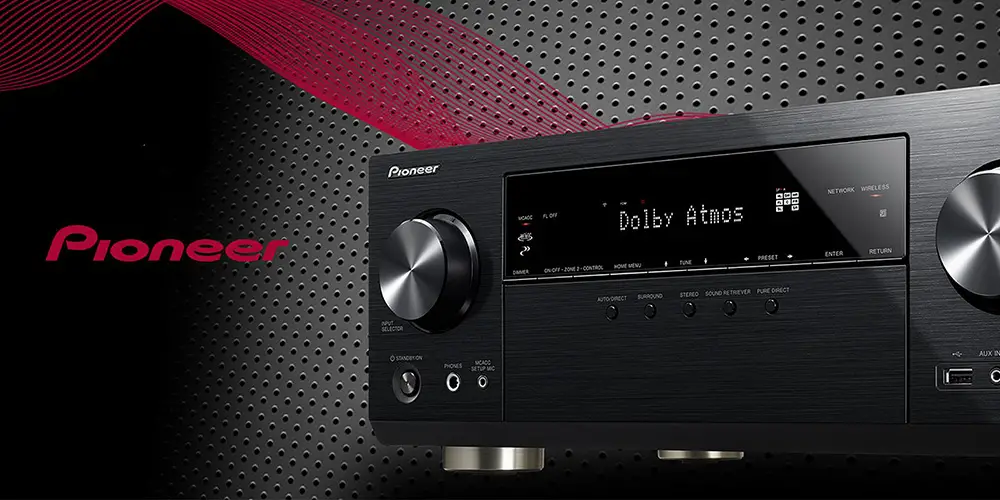
Design
As with most Pioneer receivers, this one we are looking today will not be winning any design awards but this holds true fpr most receivers nowadays as there is so much you can do to their design. As such the VSX-933 follows the same principles by being a rather boring big black box that is defined by it’s straight lines and hard edges. The receiver measures 17-1/8 x 6-13/16 x 14-9/16 inches (435 x 173 x 370.5 mm) and weights 20.7 lbs. (9.4 kg) making it a normal sized receiver for it’s category. We don’t expect you to carry this around all the time so weight shouldn’t be a problem.
The front panel features the standard design we see in almost all models with 2 big turning knobs at each side, one for volume and one for the input selection, while in the middle we get a big LED display that show various functions like volume, input selection, soundtrack type and speakers configuration. Under the display runs a thin line of buttons with another group of 5 dedicated buttons under it. Under the input knob we get the power button and next to it is a headphones jack and the calibration microphone port while under the volume knob we find a USB port and an analogue audio input.
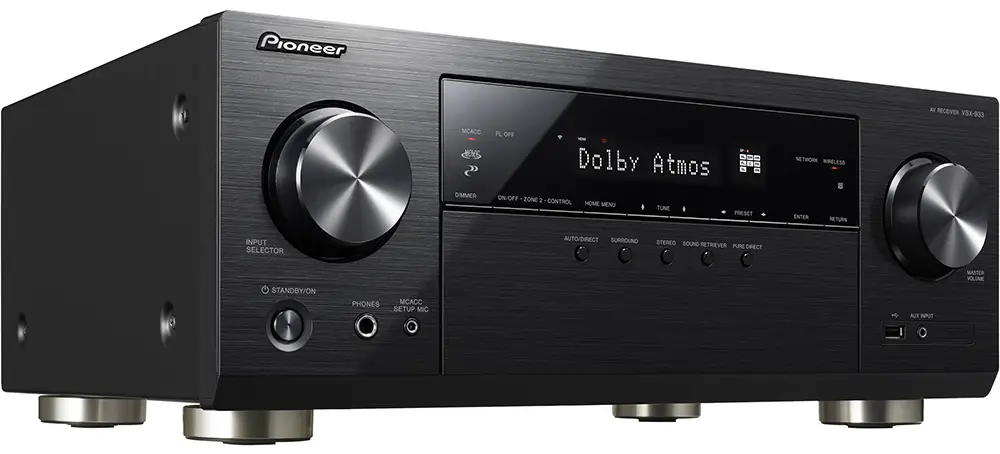
The thin buttons under the display include dimmer control, zone 2 control, menu and tuner controls. Under this the five circular sound mode buttons are for auto/direct, surround, stereo, sound retriever and pure direct. And that’s all for the front panel, nothing special to report here and if there is one thing we noticed is that there is no HDMI port which we found very useful to have in order to make quick connections. Unfortunately here there is none so you will have to use one at the back every single time.
Under the hood we find similar hardware as the one we saw in some other Pioneer receivers and as such we get a Cirrus Logic quad core 32-bit DSP as well as 384 kHz/32-bit AK4458 DACs from AKM. We noticed that hardware wise the receiver is missing some hardware that we saw in the higher models of the ELITE series and specifically it does not include the additional DSP and DACs from Texas Instruments something that seems to be the result of the lower cost of the unit.

The remote that comes with this specific model is the same as the one we saw for the two ELITE models we had recently reviewed. As such the feeling it has is rather good with the buttons feeling good enough to the touch while also having enough space between them to avoid wrong inputs. Unfortunately there is no backlight which can make the use of it a bit hard in the dark.
Buttons are separated in groups depending on their function and looking at the top they have put together the input buttons, under them we find a rather unique rhombus shaped design for the menu navigation, a big volume button sits alone under it with a small mute button to the left while at the bottom there are 9 playback and various functions buttons. The remote may be nothing special but gets the job done as it should.

Audio Quality
The VSX-933 is a 7 channels av receiver with 80 watts of power (8 ohms, 20 Hz-20 kHz, THD 0.08 %, 2ch Driven, FTC) per channel making it adequate for small home theaters, living rooms and media areas. With the 7 channels available you can create various audio setups from the most simple 2.1 to more surround capable 5.1 and 7.1 variations or go all the way to a Dolby Atmos capable system with a 5.2.2 by featuring 2 height speakers for the top layer. In our case as with all 7 channel receivers we opted for a 5.1.2 setup that features 2 height speakers positioned in the middle of our testing area.
We made all basic connections, went through the initial setup and calibrated manually the speakers so our first testing was ready to go and for that we went with the 4K UHD version of Kong: Skull Island which comes with a kick ass Dolby Atmos track. We skipped forward to the helicopters armada flying though a storm. The receiver immediately put us into the action by feeding all channels accordingly and made us feel like we were there ourselves. With every lighting strike we felt the vibrations as the subwoofer was hitting us hard and made us feel the extreme weather conditions they were trying to go through.

During the initial island bombing and during the first confrontation with Kong it became apparent to us that the receiver favored the low frequencies a bit more than what we would like and the resulting audio profile felt a bit warmer that usual. We tried to compensate this by changing settings a bit but even doing so it still felt that the receiver was leaning towards the lower end of the audio spectrum. During more quiet moments you could hear small ambient sounds from the jungle but it couldn’t offer the more delicate approach that we would like to hear. It’s as if it was asking for more low frequency mayhem to begin once again.
The VSX-933 supports also Dolby Surround and DTS Neural:X upmixing technologies. What these do is to take the various audio signals that have no surround support and by using complex algorithms they turn them into a full surround experience. Of course altering the original track by adding more depth and height may have good or bad results and it’s not a technology that will offer improved results at all times as the original mix will greatly affect the ending result. We have heard some very good performances by these up-mixing technologies and some that were more bad than we would like to remember. But nevertheless it’s an interesting feature and worth to try it our for yourself.
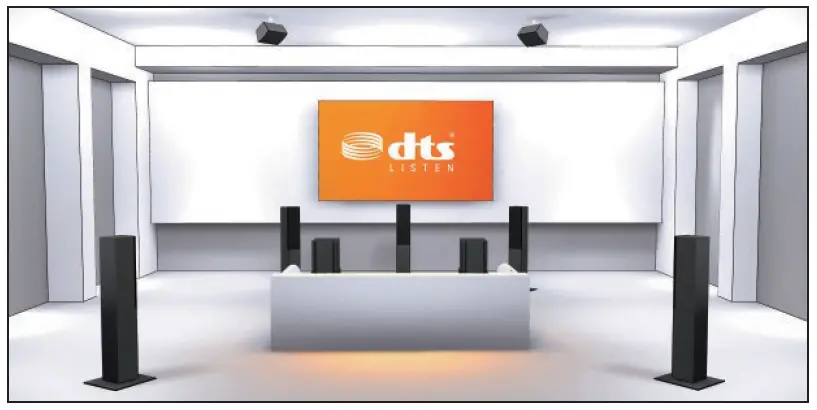
After our movie testing the time came to test how capable the receiver was with music. For this we always use a selection of FLAC tracks that offer the best quality possible and it’s easier to determine how good a receiver can do considering you have speakers that are capable at delivering the necessary quality. Here the receiver performed very well and although there were moments we heard the same kind of behavior as we did during the move testing with the unit pushing the bass a bit too hard for our liking it was not so much evident, at least not with the tracks that we tried. Overall good performance and we cannot be anything else than happy considering the cost.
The receiver supports all the known audio formats and also has the ability to playback Hi-Res Audio files that you can stream either through the on-board USB ports or from a NAS server if you have connected through your local network. The unit supports up to 192 kHz/24-bit ALAC, AIFF, FLAC, WAV (RIFF) and 5.6 MHz DSD as well as Dolby TrueHD.
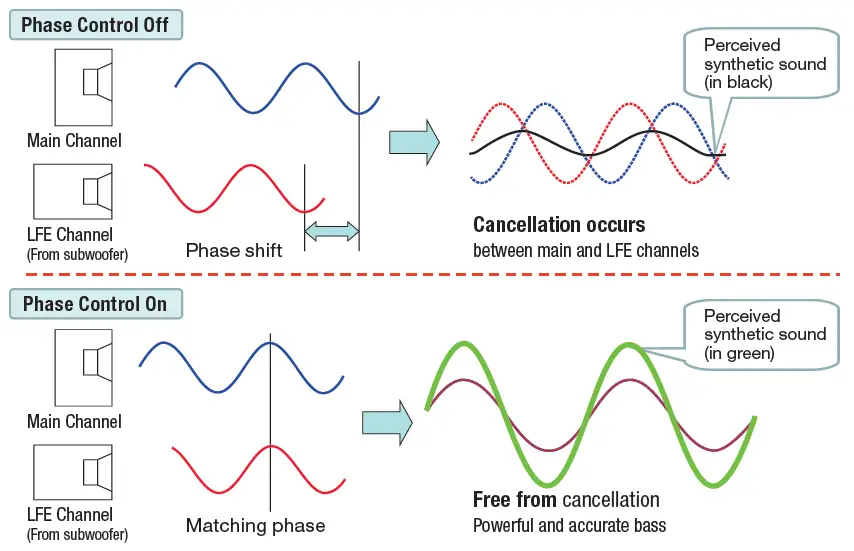
There are a couple of features that Pioneer had equipped their ELITE series of receivers that help improve the acoustic result and we are surprised to see them featured here as well. The first of these is called Phase control and what it does is to synchronize the subwoofer and main speaker channels because there is phase lag between the two that is caused by the bass management filter resulting in cancellation between the channels something that can affect the overall audio performance. As a result of this feature bass comes out accurate and powerful staying in match with the main channel at all times.
The second advanced feature we find in the unit is called Reflex Optimizer and this has to do with the Dolby Atmos height speakers that you may have in your setup. When these height speakers produce sound this comes in 2 types. High directivity sounds reflect off the ceiling while low directivity sounds reach our ears directly. This difference in their pathways create a phase shift making the sound feel a bit unnatural. The Reflex Optimizer, by using phase control technology, adjusts the shift and improves the localization of the sound image by aligning the frequencies with those of the floor speakers and as a result this creates the ideal reproduction environment.
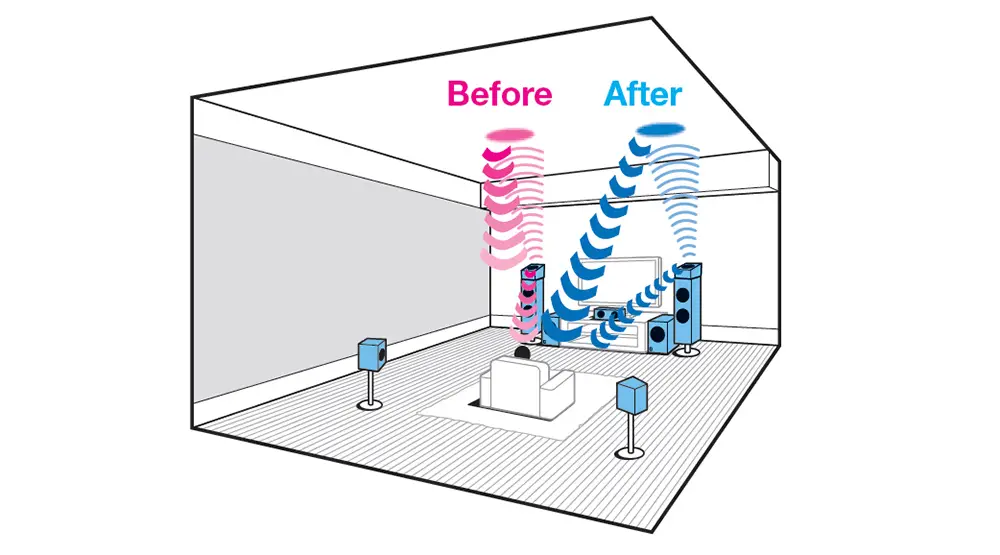
The VSX-933 offered very good performance and we are in general pleased with what we heard. It’s sound felt a bit warmer and more bass oriented compared to Onkyo for example but this may be preferable to some. Coming equipped with a couple of more advanced audio features like Phase Control and Reflex Optimizer is a plus while it’s playback capabilities were more than adequate.
Inputs / Ports
Time to check the connectivity capabilities of the receiver so looking it at the back we were a bit surprised from the amount of options we get in such a low cost unit. As we said earlier the receiver supports 7 channels of amplification so we find 7 speaker terminal plus another two for zone 2. We also get 6 HDMI inputs and 1 output which also supports ARC.
Looking at the rest we get 1 optical and 1 coaxial digital audio input, 2 composite video inputs, 1 component video input, 4 analogue stereo inputs, 1 analogue input for phono, one zone 2 ouput, 2 pre-out/subwoofer ports, another USB port, an Ethernet port for wired connections and the usual FM and AM antenna connectors. There are also 2 antennas for the built-in Bluetooth and WiFi features.
Having checked a few other Pioneer receivers we came to realize that they come a bit short on connections compared to some competitors. This is not the case here and although we are talking about a low cost unit, it provides all the necessary connectors for any kind of setup possible. Of course there are a few omissions but nothing major as all the basics are here. If there was one omission that we found a bit bothering was that there is no HDMI port at the front of the unit as it can save you from a lot of trouble if you are using such a port frequently.
OS, Apps and Features
The VSX-933 may belong on the mainstream lineup but we are very pleased to see that most of the features we found on the ELITE series found their way here also making the receiver very capable and future proof.
Upon powering up the receiver for the first time and after making all the necessary connections to the speakers and other equipment you go through a step by step wizard in order to setup your system by selecting speakers, configuration, network etc. The user interface is simple enough in order for all instructions to be clear and if you have even a little bit of experience with such setups you will have no problem here at all.
Once you go through the initial settings the UI provide all features and settings in groups that you can easily navigate and find anything you need. There is also the Pioneer Remote App that you can download for free and control the receiver through your mobile device as our day and age dictates. The app is available for both iOS and Android and it is rather well made.
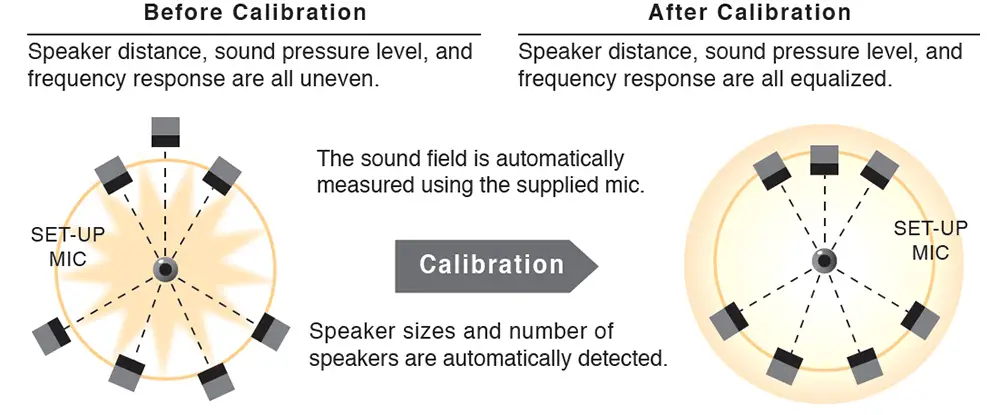
Another standard we find in all receivers nowadays either it is top of the line or dead cheap is HDMI support for HDR10, HLG (Hybrid Log-Gamma), and Dolby Vision content as well as 4K (60p/4:4:4/24-bit), Wide Color Gamut (BT.2020), and HDCP 2.2. Unfortunately there is no eARC support but this is to be expected as this is reserved for the higher tier models.
Pioneer is using in all their receivers their proprietary calibration system called MCACC (Multi-Channel Acoustic Calibration System) which was developed with the help of professional studios and can be used to automatically calibrate your audio system with the help of the included microphone.
The MCACC is using various tones in order to determine acoustic levels and change settings accordingly so if you are totally new to such calibrations then it’s a good alternative to use. Of course if you have a bit of experience, manual calibration is always the best. Also we believe that MCACC is lacking a bit compared to some other systems like Onkyo’s AccuEQ as it is lacking a bit in options and flexibility.
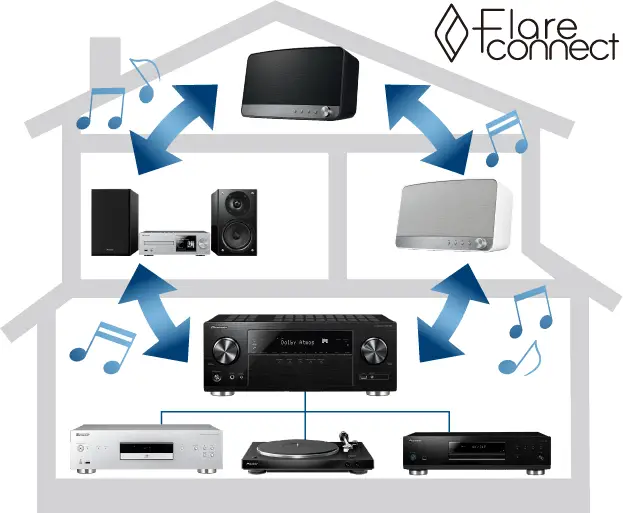
We are living in the streaming era and as such no receiver should be without such capabilities. The VSX-933 comes with a plethora of streaming services that include Amazon Music, Pandora, Spotify, TIDAL, and Deezer Music as well as Internet Radio with TuneIn. Local streaming is also an option as there is Apple Airplay support that you can use to stream audio from a smartphone or tablet.
Another feature that expands on the streaming and multi-room capabilities of the receiver is FlareConnect which lets you share audio from the network or external audio input sources. If you have supported speakers and other audio equipment you can use FlareConnect to enjoy music across your home and all this can be done through the Pioneer Remote App as you can control various functions like music selection, speakers and playback options.

We continue with the streaming features of the receiver as there is also Chromecast support that is a feature that let you stream your favorite music from a Chromecast enabled device like iPhone, iPad, Android, Mac or Chromebook. Also if you find using a remote very old fashion then the future dictates the use of voice control with the receiver giving you the ability to do so by including Google Assistant. Unfortunately there is no Alexa support so if you prefer that then you are out of luck.
Closing this part we left one last feature that we didn’t mention yet and this is DTS Play-Fi which is another multi-room function and with it you can create your own audio ecosystem in your house by streaming audio from any supported mobile device or audio equipment. And the best thing is that everything can be controlled with the Pioneer Remote App for easy access.
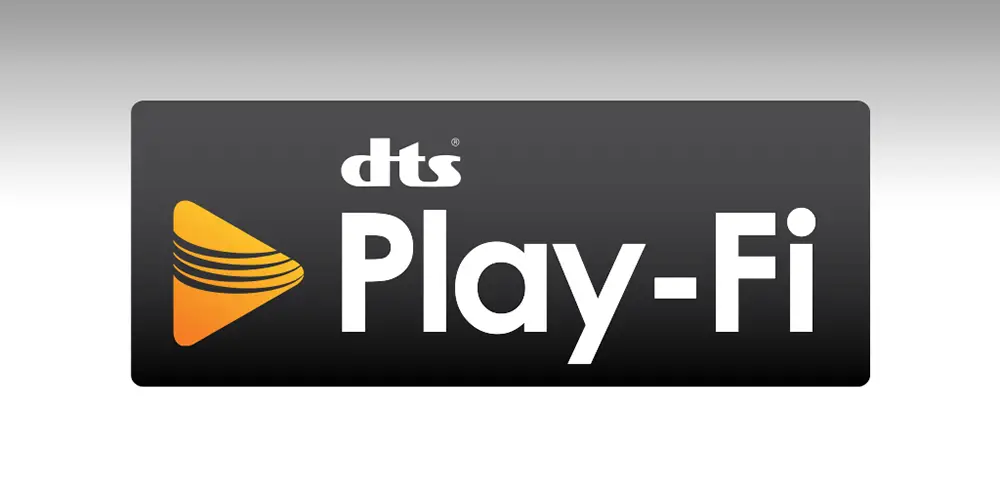
Final Thoughts
Reaching the end of our review find us with a smile on our face as the Pioneer VSX-933 managed to offer a level of quality and performance that may not mean much if you compare it with other, top tier models but when you consider how much it costs it really will make you reconsider the value it has.
Finding a receiver that has 7.2 channels, support all the latest audio formats like Dolby Atmos and DTS:X as well as upmixing technologies, support a plethora of streaming services, has enormous multi-room capabilities, offer plenty of connectivity through it ports, Bluetooth or WiFi connections, comes with voice control through Google Assistant and offer automatic calibration through the included MCACC system and all this with a price that is very close to the $300 mark is a real achievement and shows how much value such a low cost receiver carries.
On the opposite side there are not many things to ask when a receiver costs so low in price. At 80 watts the receiver may run out of juice if your area is a bit large so make sure you will use it in small home theaters, living rooms or bedrooms. Also we are missing the front HDMI port that so many other receivers have as such a port offers enormous practicality. Lastly the MCACC system is a bit lacking compared to other manufacturer’s calibration systems.
If you want a receiver that has the lowest possible cost without sacrificing any of the latest audio formats like Dolby Atmos and DTS:X or major streaming and online features then the Pioneer VSX-933 is a serious contender to consider. Pioneer packed amazing capabilities in such a low price and in this regard this unit is a winner.
For more reviews you can check our dedicated 7 channels 4K AV Receiver reviews list or even look at our Product Reviews Table where you can find the brand and specific product you are looking for.
Cheapest Places to Buy :
*We are a reader-supported website. When you buy through links on our site, we may earn a small affiliate commission at no extra cost to you. Home Media Entertainment does not accept money for reviews.*
Specifications
- Amplification : 7.2 channel AV Receiver with 80 W/ch (8 ohms, 20 Hz-20 kHz, THD 0.08 %, 2ch Driven, FTC)
- Video Features :Ultra HD Pass-through with HDCP 2.2 (4K/60p/4:4:4/24-bit, 4K/24p/4:4:4/36-bit, 4K/60p/4:2:0/36-bit), HDR10, HLG and BT.2020 Wide Color Gamut Signal Pass-through, Dolby Vision Compatible, Ultra HD Upscaling (1080p to 4K), 3D Ready (Blu-ray Disc, Broadcast, and Games), Deep Color (36-bit), “x.v.Color”
- Audio Features : Dolby Atmos, Dolby Surround Upmixer supports DTS Formats, DTS:X, DTS Neural:X Upmixer supports Dolby Formats, Reflex Optimizer, Dolby TrueHD, Dolby Digital Plus, DTS-HD Master Audio, DTS-HD High Resolution Audio, DTS 96/24, DTS-ES, DTS Express, DSD Disc (SACD) Playback via HDMI (2.8 MHz/2 ch, 5.1 ch), Audio Return Channel (ARC) on HDMI, MCACC Auto Room Tuning with Phase Control and Subwoofer EQ, Advanced Sound Retriever (2ch), Advanced Surround Modes
- Hardware : Digital Quad-Core 32-bit DSP (Cirrus Logic), 384 kHz/32-bit D/A Conversion with AK4458 (AKM)
- Home Network Features : FlareConnect for Multi-room Audio, Chromecast built-in, Works with the Google Assistant, DTS Play-Fi with Pioneer Music Control App, Apple AirPlay Certified, Internet Radio with TuneIn, Hi-Res Audio File Playback via USB/Network, Up to 192 kHz/24-bit ALAC, AIFF, FLAC, WAV (RIFF) and 5.6 MHz DSD, Dolby TrueHD
- Online Services : Amazon Music, Pandora, Spotify, TIDAL, and Deezer Music-Streaming Services Ready
- Convenience Features : Dual Band (5 GHz/2.4 GHz) Wi-Fi Built-in, Bluetooth Wireless Technology (Version: 4.1 + LE, Profile: A2DP 1.2/AVRCP 1.3, Codec: SBC/AAC) Built-in, Pioneer Remote App Ready for Multi-room Entertainment Control and Network Streaming, User-Friendly GUI with System/Network Setup Menu, Auto Power Off in HDMI Standby Through, AM/FM Tuner 40 Presets, Sleep Timer, User-Friendly Simple Remote Control

I absolutely love the way you wrote this review because it is full of great information. It is fascinating and interesting to see how such low budget receivers start to get so many features. Your review are awesome, Pioneer VSX-933 seems like a good choice for what it offers. I’m a real fan of music, but the pros really got my interest to set a budget for this. Thanks for the information. Best regards
You are welcome. You can read more of our reviews for AV receivers in the dedicated section.
They don’t make them like they used to!! https://hometheaterreview.com/pioneer-vsx-933-72-channel-network-av-receiver-reviewed/
Hello Marco. I am not sure what I should be looking at, at the link you provide. If you can clarify I would appreciate it. Thanks!